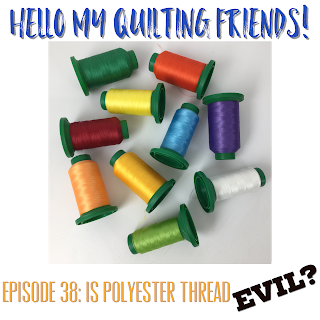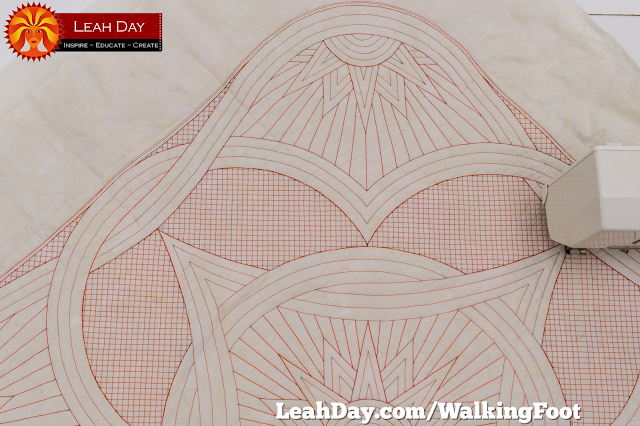Is Polyester Thread Evil? Podcast Episode #38
Or you can watch the episode and see me spinning black wool on my mini spinner here:

Click Here to find all the episodes of this podcast!
So the Great Polyester Thread Debate can be summed up pretty simply: I think this is a myth, a rumor, and just like using starch, a potential great product being demonized for no reason.
Pretty strong words? I’m just getting started!
Sure, there may be a basis for polyester thread having a bad reputation in the 1970’s when there wasn’t a lot of great quilting materials on the market. The American bicentennial created a resurgence of interest in traditional hand crafts and many people were jumping in, but manufacturers and stores just weren’t prepared for the demand.
So could there have been a situation where the cotton fabric of a quilt was shredded by strong, brittle polyester threads? Sure. I’m not denying this situation could have happened. I wasn’t alive back then so I can’t (and wouldn’t want to) defend the polyester threads of the past.
Which brings me to my second point – that was over 40 years ago!
Manufacturing has changed, new products have been invented and the polyester threads we have to work with today are just plain awesome. My favorite polyester thread is Isacord which is available in over 300 colors, comes in 1000 meter spools for around $6 and is strong, thin, and stitches beautifully.
But it really doesn’t matter what thread I like or what works best for me. The most important thing is to try it yourself.
When I stumbled across Isacord thread, I was in the middle of quilting Release Your Light, an 80-inch densely quilted art quilt that was driving me crazy because the thicker cotton threads I was using kept breaking.
I remember buying almost every type of thread my local quilt shop carried in orange and yellow. Isacord just happened to be one of the spools I grabbed that day. I didn’t ask for permission, I didn’t ask anyone’s opinion. I was desperate for a thread that could quilt more than 2 inches without breaking so I could stop tearing my hair out in frustration. Isacord worked and that was enough for me.
So I don’t believe in listening to the rumor mill or what Betty Sue at quilt guild says about using polyester thread being evil. Had I listened to that kind of thing, I might have been convinced what I was doing was wrong, even though it worked.
Ultimately all we have in any craft is personal experience and personal opinion, and the only way you can build this is by making quilts with lots of different materials and deciding what YOU like best.
This summer I learned photography on a DSLR camera so I could take the pictures for the book Explore Walking Foot Quilting. I found this very intimidating and kept searching online for the correct F-stop, shutter speed, and ISO to shoot pictures on a home sewing machine. I wanted to know the RIGHT way to do it. I didn’t want to make any mistakes or do something wrong.

Needless to say, I never found a blog post or video with that exact information. I had to figure it out myself, play with settings, play with the single kit lens I had, shoot a lot of photos and develop my own opinion about what looked good. To a different photographer, they might have picked entirely different settings and achieved a very different look.
Developing your own opinion and being willing to experiment is hard and risky. It takes a lot of patience to make an entire quilt and ultimately decide you don’t really like the effect of that batting, or you wish you’d stitched in a different color of thread. That’s frustrating, but so long as you keep some record of your progress, you’ll never have to do that again. Your opinion is strengthened and you can move forward with at least one material, one thread, one color, one fabric type scratched off your list.
And eventually you’ll find the happy place where you know exactly what works for you.
For me, that’s solid fabric or solid reading batiks, Isacord thread, and a strong contrast between my fabric and thread color. It’s also using polyester or wool batting, prewashing and starching my fabric too. That’s what works for me.
Now the question is – what works for you?
Go out and try lots of things to answer this question and try to ignore the rumor mill. Most rumors are based on some story someone heard years ago from someone else. There’s no actual, hands-on experience in rumors, and just like ghost stories, they’re probably not true.
 Now a few quick updates from around the house:
Now a few quick updates from around the house:
Make sure to check out my video on piecing a total crazy quilt, which includes a Y-Seam piecing tutorial. Yep, I’ll probably write a post on this at some point, but for now this is just on YouTube.
I’m also gearing up for our 2018 Machine Quilting Party! Are you ready to piece and quilt three quilts with me next year? Make sure to check out the materials list and schedule right here.
That’s it for this week! Make sure to check back on Friday for a video on picking your fabrics for the two quilts we’ll be starting the first week of January!
Let’s go quilt,
Leah Day


I love Isocord for quilting. Strong and great shine and finer than many quilting threads.
I actually do have a quilt that shredded on the poly/cotton blend quilting lines. However! There are more factors involved. The quilt is about 20 years old. I was using my Clark's "Double Duty" thread left over from garment sewing. I was also using "homespun" fabric from a big chain store, which is a rather fragile fabric, and, in hindsight, my quilting is way too sparse (putting more pressure on each line of quilting.) I think the upshot is that the fault lies in the fabric more than the thread, and today I am perfectly willing to use polyester thread.
In the past I thought cotton thread is the best and I used it for garments, curtains and quilt piecing. I have learned the hard way that it is not with work with curtains and quilts. I live in South America and the sun dissolves the cotton thread over time. I have an old quilt that was much loved and washed and all seams went open after the years. Now I only sew with polyester tread and that works great
I have arc and Madeira polyester thread. Should i try it or is there something about the Isacord that the others dont have. I embroider so i have a bunch of the other thread.
I would stick with what works for you! If you already have lots of Arc and Maderia and it's working well for you, why try anything else? I don't believe in shelling out tons of cash just to keep trying new things, especially when you have an established stash.
Thank you. I have never free motion quilted before, but good to know about this thread. I am set for a while then and have every color under the sun. Have a Merry Christmas.
Thank you Leah for bringing this topic up about polyester thread. I noticed that I have a lot more lint in my bobbin case when using cotton thread vs. using polyester thread. Leah, do you use polyester thread for piecing as well?
You’re completely right Diana! Cotton thread breaks down as it feeds to the machine and builds up a lot more lint in the bobbin case. No, unfortunately polyester thread is too slippery for piecing. I’m not saying I NEVER use it (because sometimes I’m too lazy to re-thread my machine), but for the most part I piece with Aurifil 50 wt Mako Cotton. It’s a lot less linty than other brands of cotton thread. I think cotton is better for piecing because it’s not slippery and really locks the pieces together.